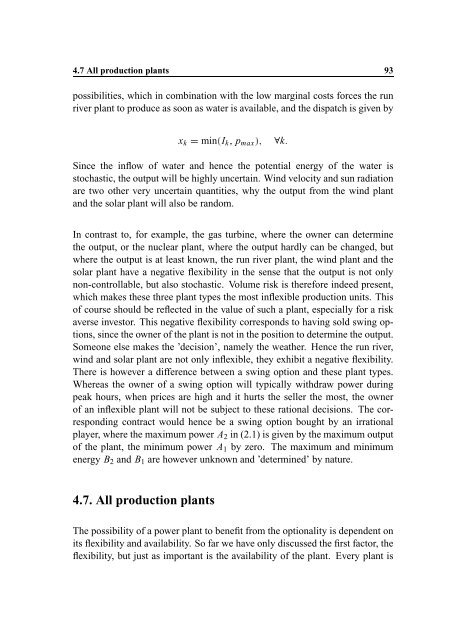Hedging Strategy and Electricity Contract Engineering - IFOR
Hedging Strategy and Electricity Contract Engineering - IFOR
Hedging Strategy and Electricity Contract Engineering - IFOR
You also want an ePaper? Increase the reach of your titles
YUMPU automatically turns print PDFs into web optimized ePapers that Google loves.
4.7 All production plants 93<br />
possibilities, which in combination with the low marginal costs forces the run<br />
river plant to produce as soon as water is available, <strong>and</strong> the dispatch is given by<br />
x k min I k<br />
š p max › š kž<br />
Since the inflow of water <strong>and</strong> hence the potential energy of the water is<br />
stochastic, the output will be highly uncertain. Wind velocity <strong>and</strong> sun radiation<br />
are two other very uncertain quantities, why the output from the wind plant<br />
<strong>and</strong> the solar plant will also be r<strong>and</strong>om.<br />
In contrast to, for example, the gas turbine, where the owner can determine<br />
the output, or the nuclear plant, where the output hardly can be changed, but<br />
where the output is at least known, the run river plant, the wind plant <strong>and</strong> the<br />
solar plant have a negative flexibility in the sense that the output is not only<br />
non-controllable, but also stochastic. Volume risk is therefore indeed present,<br />
which makes these three plant types the most inflexible production units. This<br />
of course should be reflected in the value of such a plant, especially for a risk<br />
averse investor. This negative flexibility corresponds to having sold swing options,<br />
since the owner of the plant is not in the position to determine the output.<br />
Someone else makes the ’decision’, namely the weather. Hence the run river,<br />
wind <strong>and</strong> solar plant are not only inflexible, they exhibit a negative flexibility.<br />
There is however a difference between a swing option <strong>and</strong> these plant types.<br />
Whereas the owner of a swing option will typically withdraw power during<br />
peak hours, when prices are high <strong>and</strong> it hurts the seller the most, the owner<br />
of an inflexible plant will not be subject to these rational decisions. The corresponding<br />
contract would hence be a swing option bought by an irrational<br />
player, where the maximum power A 2 in (2.1) is given by the maximum output<br />
of the plant, the minimum power A 1 by zero. The maximum <strong>and</strong> minimum<br />
energy B 2 <strong>and</strong> B 1 are however unknown <strong>and</strong> ’determined’ by nature.<br />
4.7. All production plants<br />
The possibility of a power plant to benefit from the optionality is dependent on<br />
its flexibility <strong>and</strong> availability. So far we have only discussed the first factor, the<br />
flexibility, but just as important is the availability of the plant. Every plant is
















